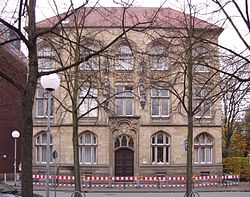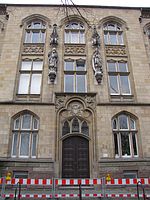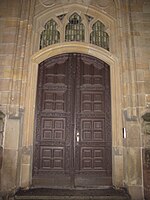Collegium Ludgerianum
| Collegium Ludgerianum | |
|---|---|
 View of the former Collegium Ludgerianum today |
|
| Data | |
| place | Münster , Domplatz 23 |
| architect | Franz Wucherpfennig |
| Construction year | 1901-1903 / 1949-50 |
| height | Three-storey m |
| Coordinates | 51 ° 57 '45.1 " N , 7 ° 37' 25.1" E |
The Collegium Ludgerianum was an episcopal convict in Münster . The name Ludgerianum is still used today for the former Konvikts building on Domplatz .
Konvikt
The Collegium Ludgerianum was intended for boys from the diocese of Münster who felt called to be priests (or who were intended to do so). Their performance had to be in the upper third of the class average. Entry was possible from high school (9th grade). The grammar school lessons up to the Abitur took place at the grammar school Paulinum . It was supplemented by spiritual and ascetic training and community life in the Konvikt.
history
founding
The Ludgerianum was founded at Easter 1849 by Bishop Johann Georg Müller . It received the name of St. Liudger , the first bishop of Munster. On Cathedral Square, south next to the bishop's palace, was Bishop Hermann Jakob Dingelstad the 1901-1904 designed by the architect Franz Münster Wucherpfennig historicist Konviktsgebäude with the town hall modeled gable built.
New building on the Ring
The Ludgerianum later moved into a new building at Kardinal-von-Galen-Ring 45. After its destruction in the Second World War , it was rebuilt in a simplified manner and reopened in 1952 as a Konvikt. Between 1960 and 1964, the Overberg College was also housed there. From 1969 the Collegium shared the building with the newly founded Peace School , an episcopal comprehensive and all-day school . The Collegium Ludgerianum was dissolved in 1971. Today the Caritas Association resides there in the diocese of Münster .
The building on Domplatz after the move
After the Konviktes moved, the original building housed the diocese's archives until the Second World War. Badly damaged in the war, the building was rebuilt in a simplified manner by 1950. From 1950 to 1960, the newly created Catholic Academy Franz-Wärme-Haus was also housed there before it moved to the new building on Lake Aasee . To finance the new building, the original building on Domplatz was sold and has since been used as a philosophical seminar at the Westphalian Wilhelms University .
Persons connected to the Ludgerianum
- Bishop Johann-Georg Müller (founder of the Konvikt)
- Chaplain Bernhard Schweling ( Rendant )
- Clemens Perger (President 1849)
- Heinrich von Droste zu Hülshoff , (District Administrator of Münster, protector of the Ludgerianum in the Kulturkampf ).
- Bishop Hermann Jakob Dingelstad (client of the building at Domplatz 23)
- Bishop Johannes Poggenburg (head of the Konvikt from 1906)
- Bishop Heinrich Tenhumberg (then as a student)
- Albert Freude (then as a student)
- Heinrich Kömstedt (President from 1866)
- Joseph Bautz (prefect of studies from 1874 to 1877)
- Heinz Bello performed air raid protection at the Ludgerianum
- Heinrich Janssen , auxiliary bishop emeritus, there in 1965 as spiritual
photos
Portal with statues of saints; right of St. Ludger with his attribute , the goose; left St. Boniface with book and ax;
Sculptor: Franz EwertzTympanum of the entrance
with the coat of arms of the builder
Bishop Hermann Jakob Dingelstad
literature
- Peter Löffler: Collegium Ludgerianum in Münster, 1849–1971. History of an episcopal educational institution , Münster 1979, ISBN 3-7923-0435-X
- Michael Hirschfeld: Catholic milieu and expellees , Böhlau, Cologne-Weimar-Vienna 2002, ISBN 978-3-412-15401-1
- Ludwig Adolf Wiese: Ordinances and laws for the higher schools in Prussia . Wiegandt, Berlin 1875 ( source in the Google book search).
Web links
Individual evidence
- ^ Press service, Diocese of Münster, October 15, 1998: Promoter of pastoral care, art and church music - Bishop Johann-Georg Müller was born 200 years ago on October 15
- ↑ The neo-Romanesque building of the Diözesanmuseum ( architecture city ms 10 | 09 ( page no longer available , search in web archives ) stood on the plot in between until 1965 Info: The link was automatically marked as defective. Please check the link according to the instructions and then remove it this note .; PDF; 854 kB)
- ↑ Imprint of the Caritasvernabdes MS ( Memento of the original dated November 8, 2011 in the Internet Archive ) Info: The archive link was automatically inserted and not yet checked. Please check the original and archive link according to the instructions and then remove this notice. , accessed November 6, 2010
- ↑ Bernd Schumacher: Overberg-Kolleg celebrates its 50th anniversary. Learning and encounter. In: kirchensite.de. Diocese of Münster, November 5, 2010, accessed on November 7, 2010 .
- ^ Westfälische Nachrichten, August 18, 2009: Peace School celebrates its 40th anniversary
- ↑ Westfälische Nachrichten, September 3, 2010: Where Münster's church history rests , accessed November 6, 2010
- ↑ architektur stadt ms 10 | 09 ( page no longer available , search in web archives ) Info: The link was automatically marked as defective. Please check the link according to the instructions and then remove this notice. (PDF; 854 kB); There is also a picture of the original east facade before 1943 with its ornamental gable modeled on the Münster town hall .
- ^ Axel Schildt : Between Occident and America. Studies on the West German landscape of ideas in the 1950s , Munich 1999, p. 154
- ↑ City magazine ECHO, September 30th, 2009: A striking building turns 50: Franz Heat House is still an eye-catcher today ( page no longer available , search in web archives ) Info: The link was automatically marked as defective. Please check the link according to the instructions and then remove this notice. , accessed November 7, 2010
- ↑ The relief shows the bishop's coat of arms with the inscription Per crucem ad lucem ("Through the cross to the light") in the upper arch field between two locked dragons . In the lower area the coat of arms is flanked by two coats of arms with the inscriptions Leone XIII Pont (ifice) Max (imo) Anno XXV ("When Leo XIII. Was Pope in the 25th year") and Guilelmo II Germ (anico) Imp (eratore) Bor (ussiae) Rege Anno XV ("When Wilhelm II was German Emperor and King of Prussia in the 15th year").



